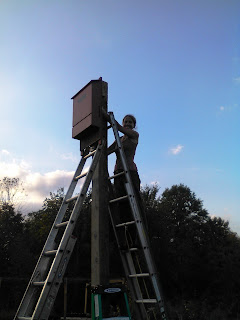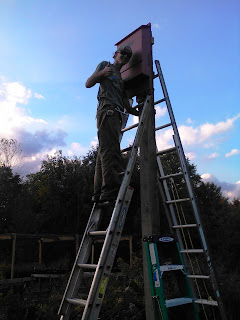If you've ever lived in an old farmhouse you can probably relate to this: oftentimes, these old houses have few-to-no heat ducts to the second floor. Couple this situation with having a wood stove on the first floor and you get: roasting hot downstairs and chilly upstairs.
Most of us also realize that heat rises so logic would tell us "cut a hole in the ceiling and let some of that heat upstairs." After a few years of scheming, looking for old heat vents and actually getting this project to the top of our to-do list, we did just that: cut some holes in the floor for passive heating to the upstairs.
We first determined the floor joist orientation and spacing so that we could get heat vents that would fit between our joists. We then cut holes in the floor upstairs using a jigsaw (sorry, no pic). The floors are pretty stout tongue and groove hardwood boards so no bracing was requires. It was simply, measure, cut hole, drop-in vent.
We then drilled holes lined up with the four corners of the hole in the upstairs floor down through the ceiling below. From these fours holes were we able to determine and mark the hole that we would cut in the downstairs ceiling. To cut these holes we used our
Rockler Versacut circular saw with masonry blade. We don't use this saw very often but, when we do, we are grateful that we have one as they are very versatile, as the name suggests.
Here we drop the cut piece out. Now we were able to measure X, Y and Z dimensions for the trim that would cover up the ugly hole from below. Basically, we made a box that would slide up into the ceiling and meet, from below, the bottom of the heat vent we had dropped into the hole we'd made in the upstairs floor.
We just so happened to have some 1/2 inch oak boards that, when ripped for the correct depth of the "box" left just enough to make the trim that would cover up the edges of the hole in the ceiling. The close-up pic below will make this clear.
We did not want to attach this trim box from below because we had nothing but plaster and lath to drive screws into. We were able to attach from above using screws through the flooring. The screws are hidden by the flange of the heat vent.
We installed another vent in the room adjacent to the living room, hoping the a hot-air-rises, cool-air-sinks dynamic would create a cycling of air.
Here is another view from below. Not perfectly square but we don't care! Our primary goal was to get the excess heat from the wood stove up into the second floor and IT HAS WORKED GREAT! This is one of that projects that was much easier than anticipated and paid off immediately. Don't just take our word for it, ask the main beneficiary....
....our first cat, Bounder, who lives upstairs and is now quite toasty:
Caution: never cut holes in walls, floors, or ceilings unless you know what you are doing with respect to bearing walls, joist spacing and location, wiring location, etc.











